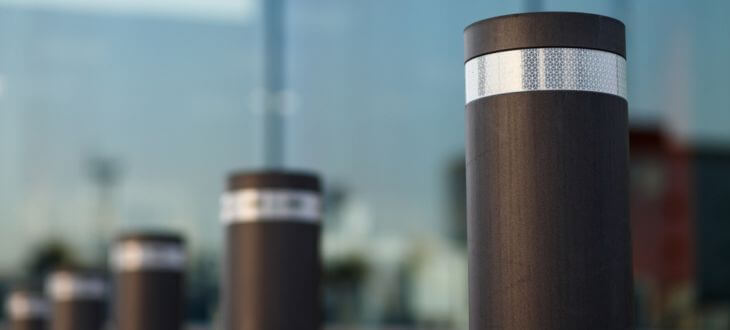Bollards, once primarily associated with maritime settings, have evolved into versatile urban fixtures serving various purposes. These short vertical posts are now ubiquitous in urban planning, providing security, aesthetic appeal, and traffic control. In this blog post, we’ll explore what bollards are, delve into the step-by-step installation process, and highlight the myriad of benefits they offer to public and private spaces.
Understanding Bollards
Bollards are sturdy, short posts in various shapes, sizes, and materials. Originally used to guide ships and prevent them from colliding with docks, they have found new life as essential elements in urban design and security. Today, bollards serve many purposes, ranging from protecting buildings and pedestrians to controlling traffic and enhancing the aesthetic appeal of public spaces.
Types of Bollards
The different types of bollards include:
- Fixed Bollards: These are permanently installed and are a robust barrier against vehicle intrusion. They are commonly used to protect buildings, storefronts, and public spaces.
- Removable Bollards: Installed with a mounting sleeve, removable bollards offer flexibility. They can be removed to allow vehicle access and replaced when security measures are required.
- Collapsible or Retractable Bollards: These can be lowered or raised as needed, providing a dynamic solution for controlling vehicle access.
- Decorative Bollards: Designed with aesthetics in mind, decorative bollards enhance the visual appeal of public spaces while still serving security or traffic control functions.
Materials Used for Bollards
Some materials you will need include:
- Steel Bollards: Sturdy and durable, steel bollards are commonly used for high-security applications.
- Concrete Bollards: Known for their strength and permanence, concrete bollards are often used in areas where aesthetics are less of a concern.
- Plastic Bollards: Lightweight and corrosion-resistant, plastic bollards are suitable for temporary and permanent installations.
- Stainless Steel Bollards: Combining durability with a sleek aesthetic, stainless steel bollards are famous for modern urban design.
How To Install Bollards
Step 1. Assess the Site and Purpose
Before installing bollards, conduct a thorough assessment of the site. Determine the intended purpose of the bollards — whether it’s to control traffic, enhance security, or contribute to the visual appeal of the space. Consider factors such as the type of bollard, material, and placement.
Step 2. Check for Underground Utilities
Before digging, ensure there are no underground utilities in the installation area. Contact local utility providers or use specialized equipment to locate and mark any buried cables, pipes, or other infrastructure.
Step 3. Select the Appropriate Bollard and Mounting Method
Choose the type of bollard that best suits your needs and the space’s aesthetic. Select the appropriate mounting method—fixed, removable, or collapsible. Consider factors such as the level of security required, the frequency of access needed, and the desired visual impact.
Step 4. Mark the Installation Points
Mark the locations where the bollards will be installed. Use spray paint or chalk to indicate the placement, ensuring proper alignment and spacing between bollards.
Step 5. Dig Foundation Holes
Dig foundation holes at each marked location using a post-hole digger or an auger. The depth and diameter of the holes will depend on the type and size of the bollards being installed. Typically, holes should be deep enough to provide stability and resist lateral forces.
Step 6. Insert Bollard and Secure in Place
Place the bollard into the foundation hole, ensuring it is level and properly aligned. For fixed bollards, fill the hole with concrete to secure the bollard in place. If installing removable or collapsible bollards, insert the mounting sleeve and secure it according to the manufacturer’s instructions.
Step 7. Allow Concrete to Cure (If Applicable)
If concrete is used to secure fixed bollards, allow it to cure completely before subjecting them to external forces. This ensures a strong and stable foundation.
Step 8. Conduct a Final Check
Once the bollards are in place, conduct a final check to ensure they are securely installed, leveled, and aligned. Verify that they meet any local building codes or regulations regarding bollard placement.
Benefits of Installing Bollards
The benefits of installing bollards include:
- Enhanced Security: Bollards act as a physical barrier, protecting buildings, pedestrians, and public spaces from vehicle intrusion and potential threats.
- Traffic Control: Bollards help regulate traffic flow in pedestrian zones, public squares, and other urban spaces, ensuring the safety of both pedestrians and drivers.
- Aesthetic Enhancement: Decorative bollards contribute to the overall visual appeal of public spaces, serving as functional art elements in urban design.
- Protection for Buildings and Infrastructure: Bollards safeguard buildings, storefronts, and other critical infrastructure from accidental collisions or intentional ramming attacks.
- Flexibility and Adaptability: Removable or collapsible bollards offer flexibility, allowing for changes in access requirements without compromising security.
- Cost-Effective Solutions: Bollards provide a cost-effective means of enhancing security and traffic control compared to alternative measures such as installing barriers or ramps.
Installing bollards is a strategic and practical approach to enhancing security, controlling traffic, and elevating the visual appeal of public and private spaces. By following the step-by-step guide outlined above, you can confidently embark on a bollard installation project and ensure the safety, functionality, and aesthetic enhancement of your chosen environment.
As urban landscapes continue to evolve, the versatility and effectiveness of bollards make them indispensable in creating secure, accessible, and visually pleasing public spaces. Whether serving as a protective barrier, traffic control measure, or design element, bollards are a testament to the synergy of form and function in modern urban planning.
Visit Tampa Steel & Supply for Quality Metal and Metal Processing Services
Do you need help with metalworking and keeping your metal fresh? The experienced professionals at Tampa Steel & Supply are here to help. We provide the highest quality of services to our customers.
Request a Quote Online
Or Call Tampa Steel & Supply at (813) 241-2801

